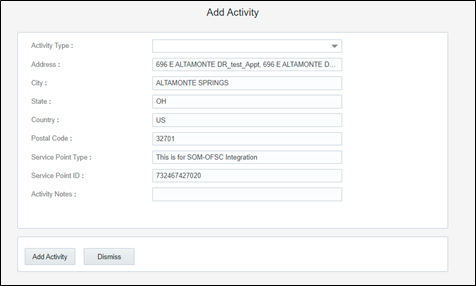Forms and Plugins
Use the plugins modify screen and data based on their type and status of target and parent object. They invoke the response for badge number input from Oracle Utilities Customer Cloud Service in the device verification plugin and retrieve the service points from Oracle Utilities Customer Cloud Service based on the search criteria by the crew in Oracle Field Service to create unrelated pickup activity using unrelated pickup activity plugin.
The Device Verification plugin accepts badge number of the device and in response sends various parameters from Oracle Utilities Customer Cloud Service, such as unit of meter, time of use, read sequence, dials, and decimals and SH data if available after verifying the badge number in the Oracle Utilities Customer Cloud Service environment.
Crew populates the search criteria in the Unrelated Pickup Activity. The plugin fetches service points from Oracle Utilities Customer Cloud Service and displays this information in Oracle Field Service. Crew can select the service point that needs to create an unrelated pickup activity.
The Service history plugin tracks the service or maintenance performed on an asset. The crew can add/save/complete/delete the service history of a meter/item/equipment.
The Attachments plugin helps crew to upload any files that are related to the activity.
The validate completion plugin helps crew to validate the eligibility to the activity to complete.
Device Verification Plugin
To configure a Device Verification plugin:
1. Navigate to Configuration > Forms and Plugins.
2. Click the Import Plugins button to import the Device Verification plugin provided in the package.

3. In the Plugin Settings pane, do the following:
1. Enter the OIC username and password.
2. Select VerifyDevice in plugin XML file.
3. Select “HTML5” from the Type drop-down list.
4. Configure the following secure parameters before using the Device Verification plugin.
Parameter Name | Value | Comments |
|---|---|---|
oic_username | Username | Configure OIC user name |
oic_password | Password | Configure OIC password |
oic_int_url | https://oichostname:port/ic/api/integration/v1/flows/rest/OUTL-BA-CCS_OFSC_DEVICE_VERIFY/1.0/ | Configure the OIC end point URL of Device Verification flow |

5. Make sure the Available Properties tab is populated with all the properties shown below.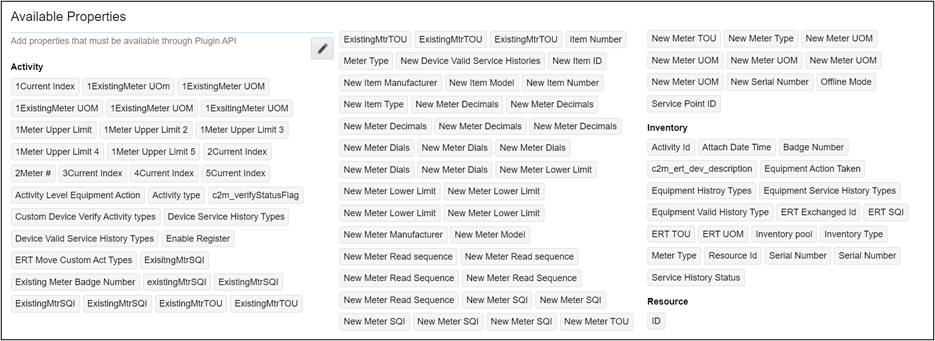

6. Click Device Verification to configure the plugin.
7. On the User Type screen configurations, select Device Verification to connect it to the specific field on the UI in the Mobility page.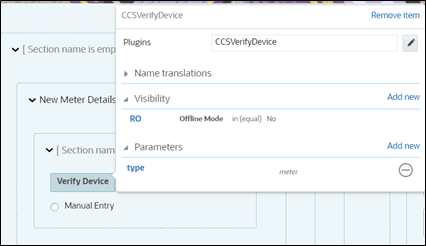
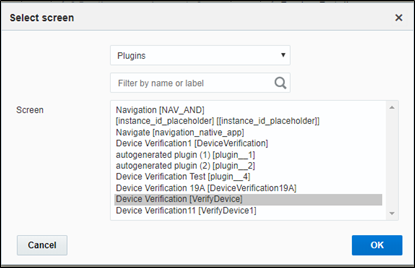


Crew could verify the existence of a device using the Device Verification feature where the search is based on Badge Number or Serial Number. Manufacturer and Model are part of Device Verification response from Oracle Utilities Customer Cloud Service and gets auto-populated in the respective fields.
To use this feature:
1. Select Install Meter Activity > New Meter Details.
2. Click Verify Device to view the existence of the device.
The Device Details page displays both Badge Number (mandatory) and Serial Number (optional).
If the device exists based on the search criteria, the New Meter Details page is displayed with autopopulated details including the register information sent by Oracle Utilities Customer Cloud Service.
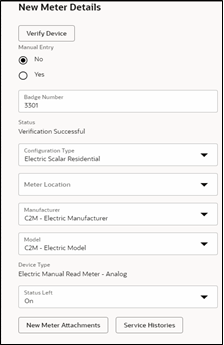
Note: The Oracle Field Service mobile device application has the capability to search the meter badge number through barcode scanner. So that no need to enter meter badge number manually while doing the device verification.
Custom Activity Type Support
The Device Verification plugin supports custom activity types other than Meter Install and Meter Exchange.
Follow the below steps to support custom activity type:
1. Log in to Oracle Field Service.
2. Navigate to Configuration, then Properties.
3. Search for the c2m_device_verify_act_types property.
4. Click Modify.
5. Add the Enum entry.
6. Enter the Activity Type Label in the Index field and Device Type in the Value field.

Unrelated Pickup Activity
To configure an unrelated pickup activity:
1. On the Configuration page, navigate to Forms & Plugins.
2. Click the Import icon to import the Unrelated Pickup plugin provided in the package.
3. Select the unrelated pickup plugin and enter the following details:
Parameter Name | Value | Comments |
|---|---|---|
oic_int_url | https://oichost/ic/api/integration/v1/flows/rest/ OUTL-BA-CCS_OFSC_SP_QUERY/1.0/ | Configure the activated service point url. |
oic_username | User Name | Configure the OIC user name |
oic_password | Password | Configure the OIC password |
ofsc_username | OFSC user name | Configure the OFSC user name |
ofsc_password | OFSC password | Configure the OFSC Password |
ofsc_bucket | OFSC Bucket External ID | Configure the OFSC Bucket |
ofsc_api_url | OFSC REST API url (Ex: https://api.etadirect.com) | Configure the OFSC REST API url |
latitude_format | Latitue format value (Ex:N2.7) | Configure the format of latitude |
longitude_format | Longitude format value (Ex:N3.7) | Configure the format of longitude |
Note: Username and password would be the client ID and client secret that can be retrieved from Oracle Field Service. 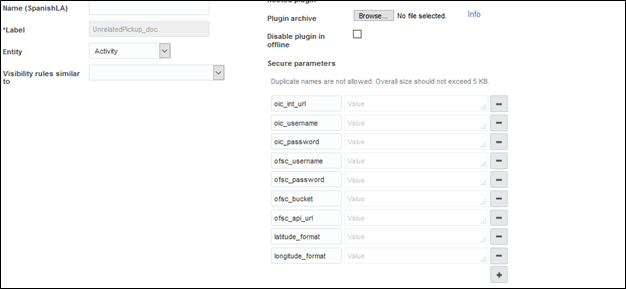

4. Click Configuration and select the user type.
5. Navigate to the Screen Configuration tab.
6. Click Application screens to display the structure. Click Activity list. 

7. On the left pane, click Click to add and select the unrelated plugin.

8. On the right pane, add new visibility.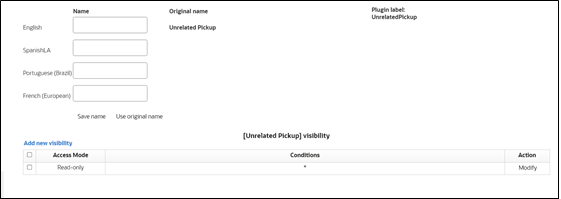

9. Make sure the Available Properties tab displays all the properties as shown in the figure below.

10. After the plugin is configured, select the XML file in the User Type Screen Configurations field to connect it to the specific field on the UI in the Mobility page.
CORS Setup
As part of the unrelated pick up functionality, from the plugin, there is an invocation call to OFSC REST API which needs CORS setup.
To call OFSC REST API from the plugin, set up cross-origin resource sharing (CORS) in Oracle Field Service as follows:
1. Navigate to Configuration > Applications > Additional restrictions.
2. Select Allow Cross-origin resource sharing (CORS) from the following web domains and provide the Oracle Field Service domain.
3. If the domain details are unknown, enter an asterisk (*). For the actual Oracle Field Service domain contact the Oracle Field Service support team.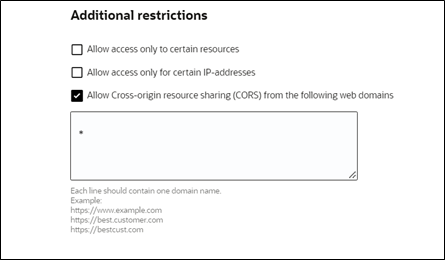

Crew can specify search criteria and send request to Oracle Utilities Customer Cloud Service for service points. From the retrieved service points, crew can select a service point and raise a service investigation activity. The search criteria includes address, city, postal code, latitude and longitude.
1. On the Mobility page, select Unrelated Pickup to use this feature.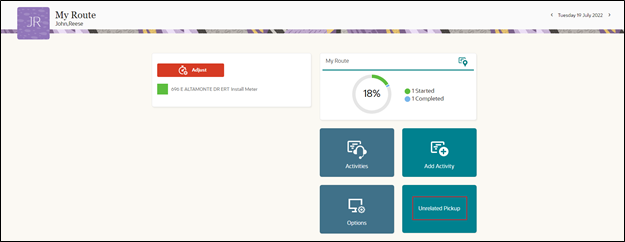

2. On the Unrelated Pickup page search for service points.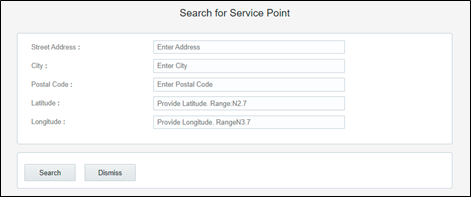



3. Select the desired service point from the list and click Select.
4. Click Add Activity to create the activity.
After successful creation of the activity in Oracle Field Service, the corresponding activity is created in Oracle Utilities Customer Cloud Service.